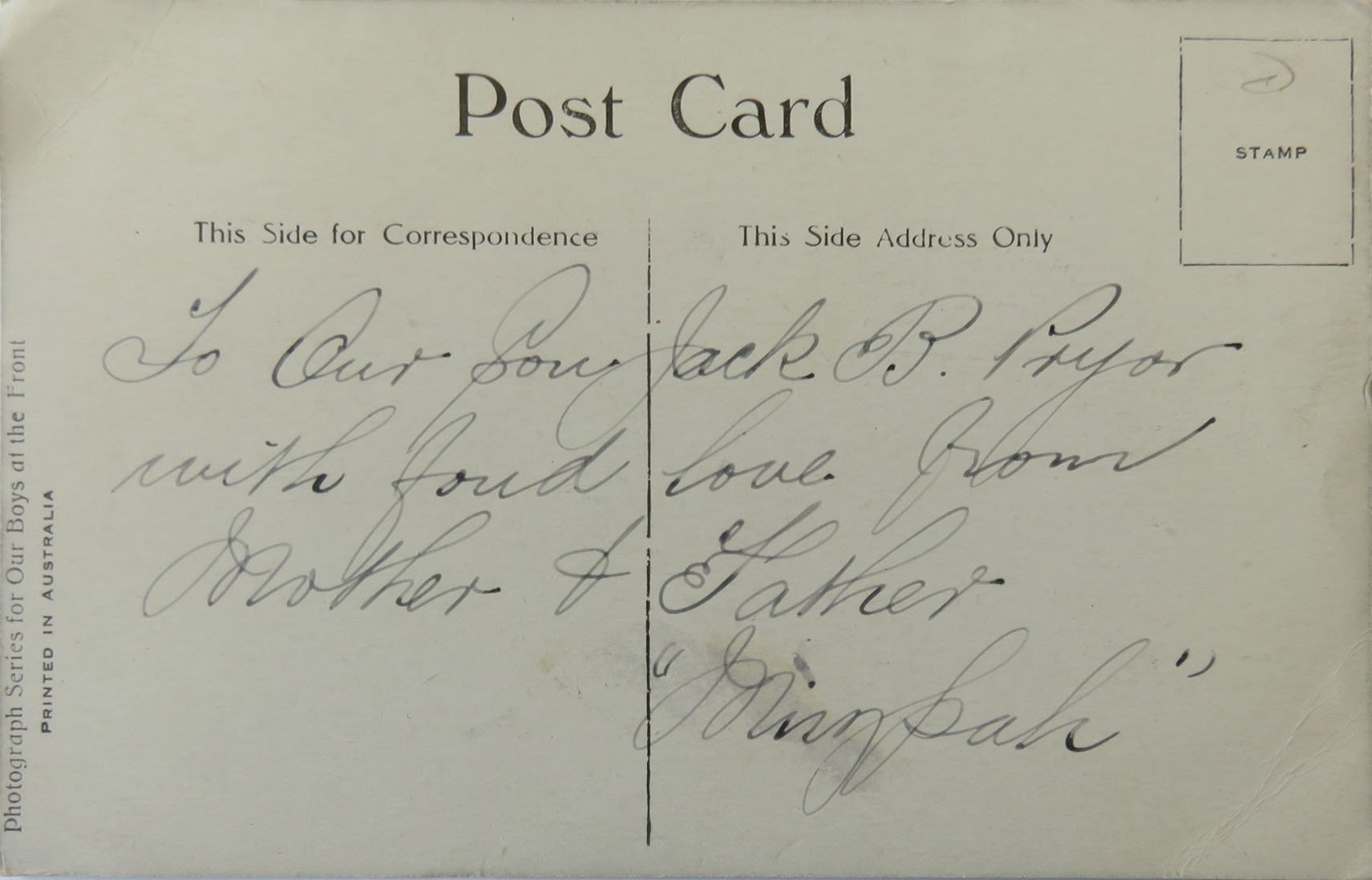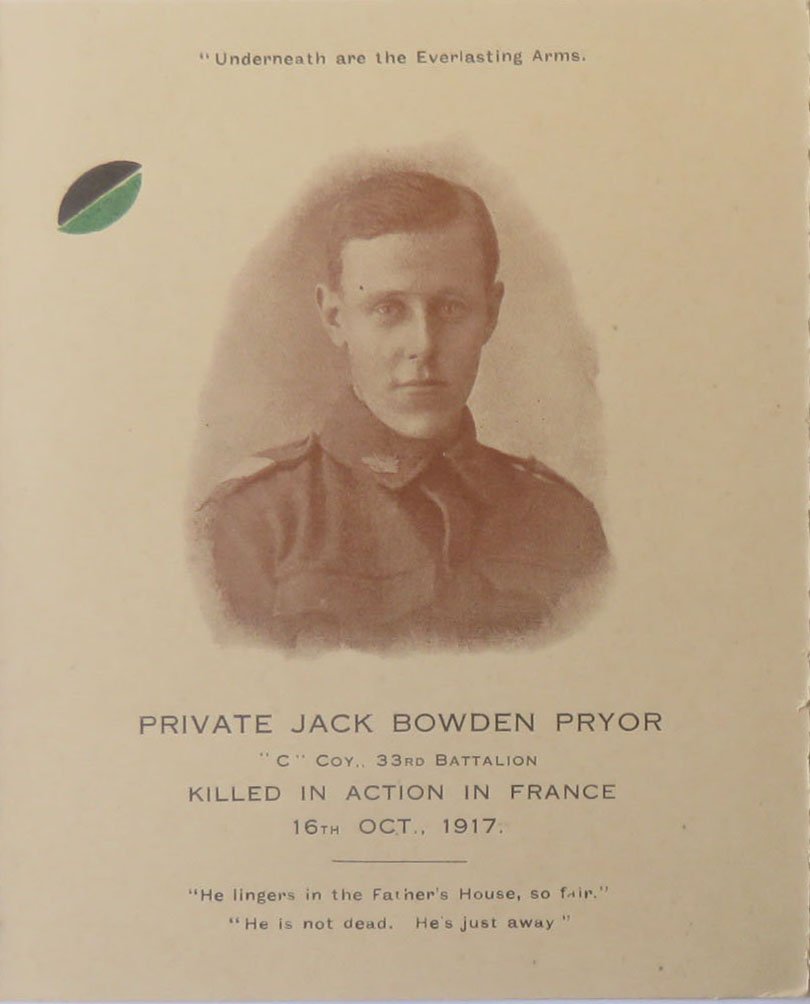Jack Bowden Pryor
Jack Bowden Pryor was one of the many young men from Maitland who enlisted in the AIF during the First World War and served on the Western Front. He was killed in action on 16 October 1917 during the Battle for Passchendaele. He was 27 years old.
Jack Bowden Pryor, 1916
Jack Pryor’s nephew, David Sciffer, inherited photographs, documents and memorabilia that convey a little of Pryor’s experiences and that, importantly, remember him as the young man who grew up, married and worked in Maitland and then went off to war.
David Sciffer kindly lent his collection for the Maitland remembers Passchendaele exhibitions held in 2017. Sciffer’s collection also underpins the story presented here.
Technical training, trade and faith
Jack was the eldest of the seven children of Benjamin and Marian (nee Gill) Pryor. His father, with Archie Pender, founded Pryor and Pender (later B Pryor and Sons), plasterers, located behind the Maitland Town Hall.
Jack learned the family trade and joined the family business. In late 1912, for example, the Maitland Mercury reported that he and his father were doing the plastering for the new West Maitland Methodist parsonage. They were among other tradesmen who were Methodists and employed to work on the building. This, according to the paper, ‘ensured that affectionate interest in the work reinforced the natural disposition to do the work in a sound, honest fashion.’ (Maitland Mercury, 18 December 1912)
Jack Pryor’s certificate for passing examinations for ‘Modelling ornaments’ at the West Maitland Technical College, March 1911
left: Jack Pryor’s Methodist Church membership, June 1910
There are three of these membership cards in David Sciffer’s collection.
right: Temperance oath signed by Jack Pryor, 20 May 1906
Temperance was an important part of Methodist practice and beliefs at the time.
click on above images for larger views
Enlistment and marriage
On 30 September 1916 Jack enlisted in the army. Two weeks later he married Ellen Edith Mayo at the Congregational Church in Maitland. It is likely that, as for so many other couples, enlistment and the prospect of going overseas to fight proved incentives at least to bring marriages forward.
Description of wedding of Jack Pryor and Ella Mayo, Maitland Mercury, 25 November 1916.
Jack Pryor enlisted at Rutherford and trained there and at the Liverpool Camp in Sydney. Attached first to the 34th Battalion (‘Maitland’s Own’), he was transferred to the 33rd Battalion just before leaving for England on 24 January 1917. In England he spent time at Lark Hill and Durrington army training camps on the Salisbury Plain. In July 1917 he was sent to the Western Front.
Postcard sent by Jack’s parents to Jack, undated
click on above images for larger views
Letters home
Pryor wrote letters to his wife, parents and his brother. David Sciffer has some of the letters.
First pages of three of Jack Pryor’s letters
click on above images for larger views
Pryor writes about daily routines and events, homesickness, the importance of letters from home, sightseeing in England, censorship and the limits on what he can share, other ‘boys’ from Maitland who enlisted and, behind the chattiness, a sense of the ever-present war and its impact.
The following excerpts provide a small taste of Jack’s story as he shared it through his letters. The excerpts are arranged chronologically tracking Jack’s experience leaving Australia, at sea, training in England and on the Western Front. The challenge is to imagine the emotions that sit behind these phrases.
… called back to get our final issue of clothes (Liverpool, Sydney, 15 January 1917)
... fill in what spare time I get writing or dreaming about my little wife (at sea, undated)
There are a few things that might interest you if I could write them but the censor says blue pencil costs money. (at sea, undated)
Arrived in England on 27th after about 8 weeks trip (Plymouth, 31 March 1917).
… when you are worrying about coming away and getting married at the same time it keeps you busy (Plymouth, 31 March 1917)
I saw Tom Sawyer yesterday. He had a letter from Jack and tells me that Fred Mannall is missing … (Lark Hill, 31 May 1917)
Tom Sawyer was a shop assistant from Maitland. He served in the 34th Battalion. He was killed in action at Morlancourt France in early May 1918.
Fred Mannall was a grocer from Maitland. He was also a Methodist which is presumably how he was known to Jack Pryor. Mannall enlisted in 1915, survived the war, and returned to Australia in 1919.
I wish you could have seen Salisbury cathedral (Lark Hill, 31 May 1917)
Very sorry to hear about Arnold Worboys … Yes, there has been some stiff fighting going on. (Lark Hill, 17 June 1917)
Arnold Worboys was from Maitland, also a Methodist. He enlisted in 1915, and was killed in action at Villers-Bretonneux in March 1917.
Tell mother I made a blanc mange for dinner today (Lark Hill, 17 June 1917)
Our Heavenly Father’s love and care seems the only thing to keep one going from day to day (Lark Hill, 17 June 1917)
I generally find I’m in arrears with my washing (Durrington, 21 June 1917)
I’m still looking to be back home again some day (on active service, 29 July 1917)
We were a fair distance away from the lines and no one seems to bother about a stray shell. (France, 19 August 1917)
I was sitting outside this morning and listening to the church bells and the sound made me think of home. We are still resting but I hope to have a different sort of rest when I get home. (France, 9 September 1917)
I am on the machine gun in my platoon. One thing about it I have learned is that I’m a sort of pack horse. Beside my rifle and usual supply of ammunition etc I’m expected to cart along another four hundred rounds when out for business so it’s some load if you go far enough. (France, 18 September 1917)
I got eight letters on Saturday night …and the same again tonight (France, 18 September 1917)
I know I won’t be sorry to be back home again. (France, 18 September 1917)
Jack’s service outlined in his AIF service file
Killed in action
Jack Pryor was killed in action on 16 October 1917 during the First Battle for Passchendaele.
The vicious fighting took place in the most appalling of waterlogged conditions, which helped render the name Passchendaele a synonym for slaughter. (Australian War Memorial)
Pryor’s Red Cross Wounded and Missing File records over 35 different eyewitness accounts of his death. The descriptions mark the mud, chaos and trauma that was Passchendaele, and how difficult it was to know exactly what happened to individual soldiers. The accounts mostly agree that he was killed while being treated for trench foot in a tent a little way back from the front line, and that he was buried nearby. Other details differ and, quite eerily, the biggest differences are in the descriptions of Pryor himself: they include him being ‘short and fair’; ‘from Newcastle… fair, one child’; ‘nuggety’; ‘medium build’; ‘5 ft 6 inches’; ‘5ft 10 inches’;’4 ft 4’; ‘plasterer by trade’.
One of the eyewitness accounts collected by the Red Cross
Maitland Weekly Mercury, 24 November 1917
Jack’s brother Ray survived the war and returned to Australia.
A poignant letter from Ella Pryor, Jack Pryor’s widow, seeking information and expressing disbelief, 12 December 1917
Jack’s personal effects returned to his parents
Mementoes and memorials
Jack’s parents clearly kept, and treasured, the letters he wrote home, as well as condolence correspondence, a memorial card and other items to remind them of their eldest child.
Memorial card and condolence thank you
The memorial card has the black over green colour patch of the 33rd Infantry Battalion in the top left corner.
click on above images for larger views
Maitland Weekly Mercury, 23 October 1920
One of the in memoriam and Honour Roll notices Jack’s parents and wife placed in the local paper.
In 1920 Jack’s body was exhumed from the battlefield and reburied at Menin Gate.
Jack’s gravestone in Ypres Town Cemetery Extension, Menin Gate
(photograph: David Sciffer)
At the base of the gravestone, hidden by the plants, is the inscription ‘Father in thy gracious keeping leave we now thy servant sleeping’.
Jack’s name is on the War Memorial in Maitland Park. He is also memorialised on his parents’ gravestone. (NSW War Memorials Register)
Gravestone of Benjamin and Marian Pryor, Rutherford Cemetery Section 3B, Plot 20
Inscribed across the bottom: ‘Pte J B Pryor, aged 26 years, Menin Gate, France, 1914-1918’
References
33rd Australian Infantry Battalion War Diary, Australian War Memorial.
AIF service file of Arnold Worboys, National Archives of Australia: B2455 Arnold Worboys.
AIF service file of Fred Mannall, National Archives of Australia: B2455 Frederick Mannall.
AIF service file of Jack Bowden Pryor, National Archives of Australia: B2455 Jack Bowden Pryor.
AIF service file of Raymond Pryor, National Archives of Australia: B2455 Raymond Foster Pryor.
AIF service file of Thomas Sawyer, National Archives of Australia: B2455 Thomas Sawyer.
Campbell, Ann (ed.), Maitland’s Great War: World War I Extracts from the Maitland Weekly Mercury and the Maitland Mercury, Maitland, Maitland Family History Circle, 2002.
David Sciffer, pers. comm., Maitland, 9 March 2017 and 28 July 2023.
Jack Pryor personal papers, David Sciffer collection.
Jack Bowden Pryor, Commonwealth War Graves Commission.
Maitland Mercury.
Maitland Park War Memorial, NSW War Memorials Register.
Private Jack Bowden Pryor, Commonwealth War Graves Commission.
The AIF Project, UNSW Canberra at the Australian Defence Force Academy.























